Unit 19 - Nervous System pt. 2 (protective features, brain)
protective features, brain
-
What are the protective features of the CNS?
- Bone: skull and vertebral column
- Meninges: CT around brain and spinal cord
- Cerebrospinal fluid (CSF): surrounds brain and spinal cord
- Blood brain barrier (BBB)
- Cerebral Arterial Circle: cerebral arteries form circle at base of forebrain
-
What are the layers of Meninges?
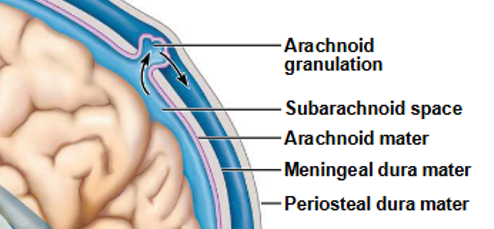
- dura mater (outer)
- arachnoid mater (middle)
- pia mater (inner)
-
What is the dura mater layer of the meninges?
- on brain it has 2 fused layers separated in some places to form spaces which are called venous (dural) sinuses and contain blood
- on spinal cord it has 1 layer
-
What is around the dura mater layer of the meninges?
- deep to dura mater is subdural space filled with ISF
- superficial to dura mater is epidural space (spinal cord only) filled with fat, blood vessels, CT, etc.
-
What is the arachnoid mater layer of the meninges?
- middle layer of the meninges
- avascular
- has arachnoid granulations (brain only) that project into dural sinuses
o CSF enters granulations to return to blood
-
What is around the arachnoid mater layer of the meninges?
subarachnoid space:
o contains cerebrospinal fluid
o web-like strands of CT secure it to pia mater below
-
What is the pia mater layer of the meninges?
- inner layer of the meninges
- on surface of CNS (brain and spinal cord)
- vascular
-
What is meningitis?
- inflamation of meninges
-
Where is Cerebrospinal Fluid (CSF)?
surrounds brain and spinal cord
in brain ventricles and central canal of spinal cord
-
What is Cerebrospinal Fluid (CSF)? What is it produced by?
cushions CNS – brain buoyant
formed from blood plasma (similar composition)
produced by choroid plexuses (blood capillaries) found in each ventricle
-
What is the circulation of Cerebrospinal Fluid (CSF)?
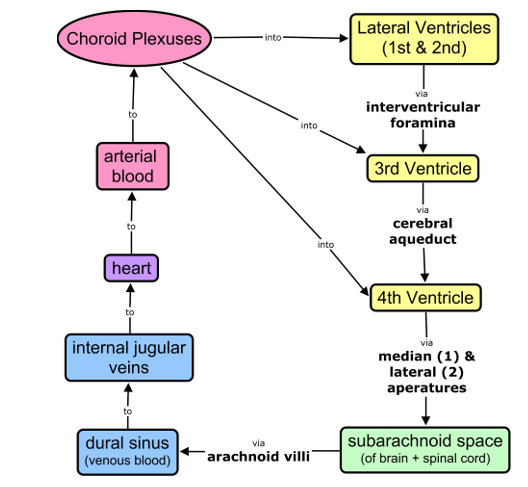
-
What are brain ventricles?
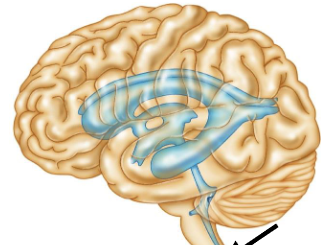
- spaces inside brain (filled with CSF)
- 2 lateral ventricles (1st and 2nd) – in cerebrum
- 3rd ventricle = in diencephalon
- 4th ventricle = surrounded by pons, medulla oblongata, cerebrum
-
What are the two cells types in the blood brain barrier?
- endothelial cells (of capillaries) with tight junctions
- astrocytes – foot processes wrap around endothelial cells
-
Is the blood brain barrier permeable?
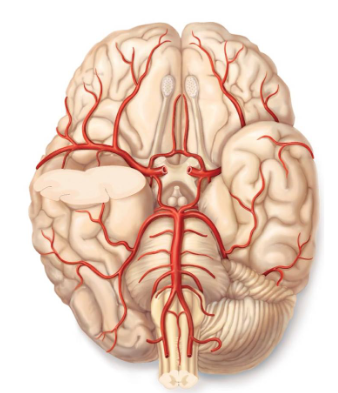
- selectively permeable
- allows: glucose, fat soluble material
- not toxins, antibiotics, etc.
-
What is the cerebral arterial circle? What does it do>
- cerebral arteries form circle at base of forebrain
o circles pituitary gland and optic chiasma (where optic nerves cross)
o unites the two major blood supplies to the brain (anterior and posterior)
o provides an alternate route for blood if vessels blocked
-
How does the blood flow to brain posteriorly?
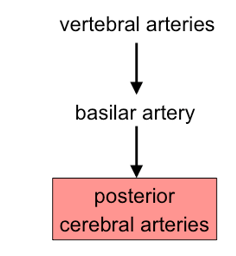
-
How does the blood flow to brain anteriorly?
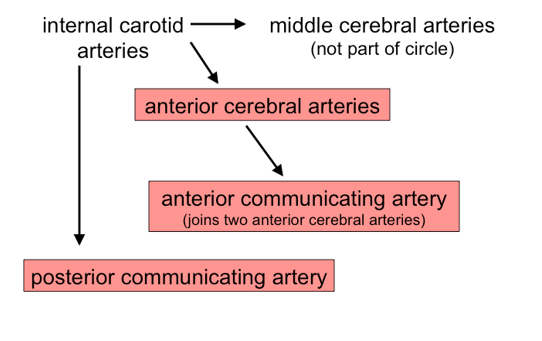
-
How does the blood return to brain posteriorly?

-
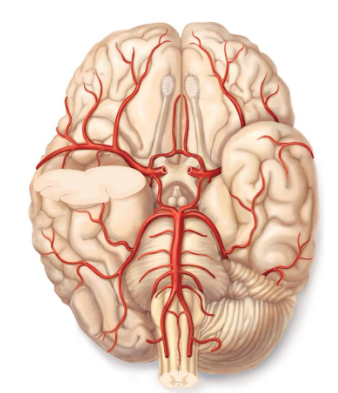
Where is the posterior cerebral artery, posterior communicating artery, and anterior cerebral artery?
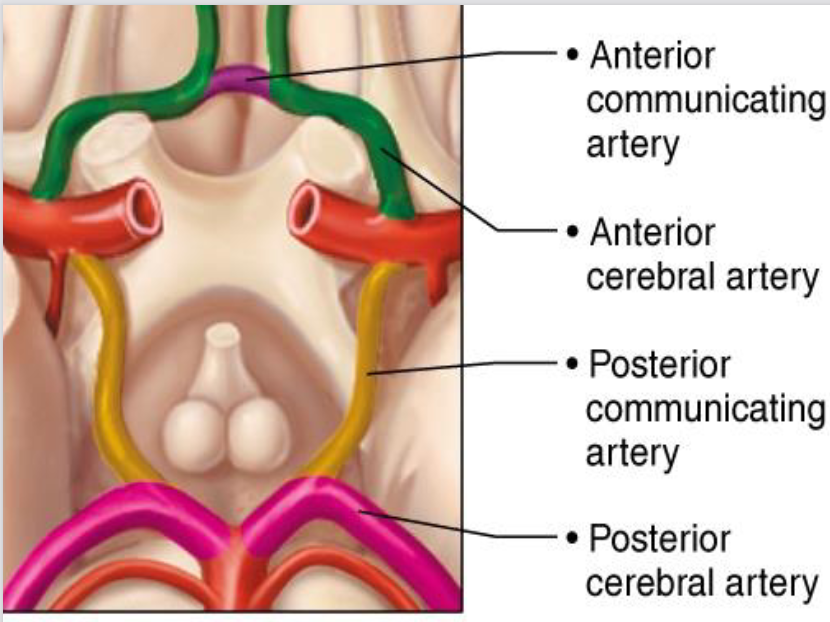
-
What are the functional systems of the brain?
limbic system and reticular formation
-
What is the limbic system?
nuclei in cerebrum and diencephalon
regulates emotions (laughing, crying, etc.)
contains areas involved in memory (memories evoke emotional responses)
-
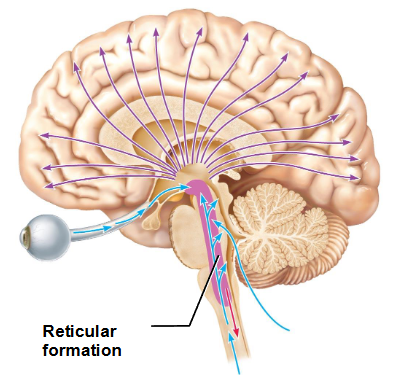
What is the reticular formation? What does it do?
nuclei in brain stem
cortex, thalamus, and hypothalamus are involved (together form RAS = Reticular Activating System)
regulates alertness and attention
filters stimuli, so only sends new/unusual signals to other brain areas
sleep results when inhibited
if damaged = coma
-
What are the parts of brain? (most encompassing parts)
forebrain, diencephalon, midbrain, and hindbrain
-
What are the two divisions of the forebrain?
the right and left cerebral hemispheres
-
What are the lobes in each cerebral hemisphere?
- named after their overlying bones:
- frontal lobe
- temporal lobe
- parietal lobe
- occipital lobe
- insula (deep to temporal lobe)
-
What are surface features of cerebrum?
- fissures (deep grooves)
- gyri (ridges)
- sulci (shallow grooves that separate gyri)
-
What are the 3 fissures of the cerebrum?
- longitudinal fissure: separates right and left cerebral hemispheres
- transverse fissure: separates cerebellum and cerebrum
- lateral fissure: separates temporal lobe from rest of cerebrum
-
What are examples of gyri and sulci?
o postcentral gyrus in parietal lobe
o precentral gyrus in frontal lobe
o central sulcus – between frontal and parietal lobes
-
What are the 3 layers of the cerebrum?
- cerebral cortex (2 - 4mm thick, grey matter)
- tracts (white matter)
- basal nuclei
-
What are the functional areas of the cerebral cortex?
motor areas, sensory areas, association areas, and others like memory (temporal lobes) and conscious intellect (personality, learning, ideas, etc.) in the prefrontal cortex
-
Where are the motor areas of the cerebral cortex, what do they do and what are their regions?
all in frontal lobe
control skeletal muscle movement
3 regions: primary motor area (precentral gyrus), premotor area, Broca’s area (motor speech)
-
Where are the sensory areas of the cerebral cortex, what do they do and what are their regions?
- general sensory area (pain, touch, temp, pressure): postcentral gyrus in parietal lobe
- vision: occipital lobe
- auditory and olfaction: temporal lobe
- taste and visceral sensation (e.g. full bladder): insula
-
What do the association areas of the cerebral cortex do?
recognize info from memories: parietal, occipital, temporal lobes
-
What are the types of tracts (white matter)?
- association tracts: from gyrus to gyrus in same hemisphere
- commissural tracts: from gyrus to gyrus in opposite hemispheres e.g. corpus callosum
- projection tracts: run vertically (brain to spinal cord / spinal cord to brain)
-
What are basal nuclei? What do they do?
paired masses of gray matter (within white matter)
control skeletal muscle movement
-
What is diencephalon? What are its 2 parts?
- all grey matter
- 2 parts: thalamus and hypothalamus
-
What is the thalamus? What does it do?
2 lobes connected by intermediate mass (bridge through 3rd ventricle)
relay station for impulses coming to cortex (from spinal cord)
-
What is the hypothalamus? What does it do?
inferior to thalamus, above pituitary
major regulator of the internal environment (visceral control) e.g. blood pressure, heart rate
-
What does the midbrain do? What does it contain?
connects pons and diencephalon
contains cerebral aqueduct
-
What does the anterior portion of the midbrain have and do?
- anterior portion: cerebral peduncles (projection tracts)
- posterior portion: 4 nuclei = corpora quadrigemina
o 2 superior colliculi: visual reflexes
o 2 inferior colliculi: hearing
-
What is the brain stem?
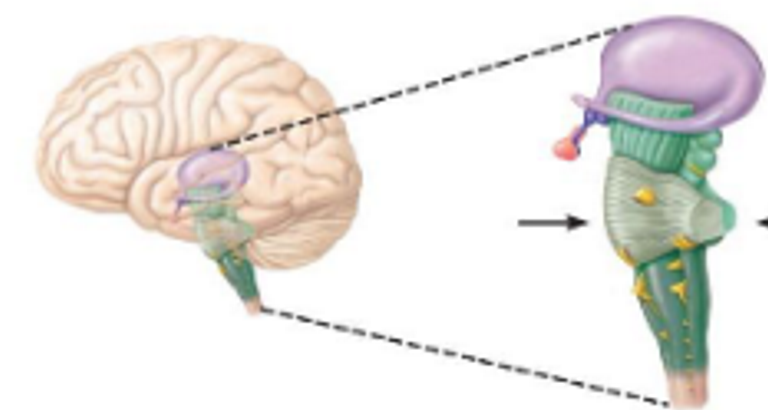
midbrain, pons, medulla
-
What is the pons? Where is it? What does it do?
part of the hindbrain
anterior to cerebellum
tracts between brain and spinal cord, and tracts to/from cerebellum
pontine respiratory centres
-
What is the medulla? Where is it? What does it do?
part of the hindbrain and inferior to pons
ends at foramen magnum
2 bulges (called pyramids) are large motor tracts (part of corticospinal tracts) just above spinal cord is the decussation (crossover) of pyramids
3 vital centres in medulla: cardiac, vasomotor (blood vessels), respiratory
several non-vital centres for swallowing, sneezing, vomiting
-
What is the cerebellum? What does it do?
part of hindbrain and posterior to pons/medulla
has folds similar to gyri named folia
cortex is gray matter
arbor vitae (deep to cortex) is white matter
coordinates skeletal muscle contraction for balance and posture
-
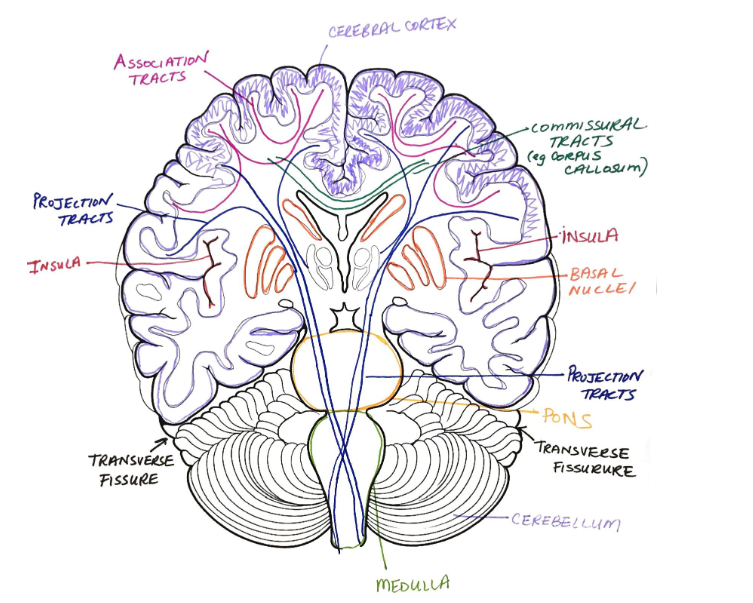
What is the dark blue X over the medulla?
- 2 bulges (called pyramids) are large motor tracts (part of corticospinal tracts)
- the X, just above spinal cord, is the decussation (crossover) of pyramids

